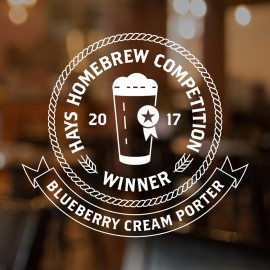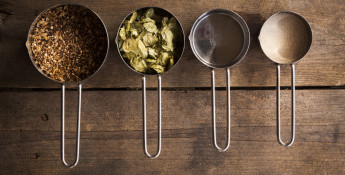By Rick McNary on December 18, 2017
The Art of Home Brewing
The hobby of home brewing is becoming popular

Have you ever wanted to brew your own beer at home? According to the American Homebrewing Association, 1.2 million brewers are jumping feet first into this exciting hobby.
Shane MacNair is one of those folks, and he’s got some chops behind his brew. He won the Brewer’s Choice the first time he entered his Blueberry Cream Porter in the Home Brew Competition in Hays. Home brewers from Kansas and Missouri competed for one of two awards at Brews on the Bricks 2017. Professional brewmasters selected the winner of the first place Brewer’s Choice award and ticketholders chose the winner of the second-place prize, People’s Choice.
“My friends kept telling me I won but I didn’t believe them,” Shane says. “It was my first contest and I was up against some pretty stiff competition. The best part of winning was that the local brewery, Gella’s Diner & Lb. Brewing Co, brewed a batch of my beer and had it on tap until it ran out.”
Although Shane won the competition in April, he waited until harvest was over on the family farm before he was able to work with brewmaster, Brendan Arnold, to mix his batch.
“Shane was a pleasure to work with,” Brendan says. “We made five barrels, which is 155 gallons. He took home 15 gallons and we sold the rest in less than four weeks. People really liked his beer.”
“That competition for home brews wouldn’t have been possible in 2013 when I first started brewing,” Shane says. “The state regulations then prohibited home brew from even leaving the premises, so if you brewed it, you had to drink it on your own property. They’ve relaxed some of the laws but are still pretty stringent.”
Brewing at Home
The craft beer industry has doubled in the last five years in the U.S., providing more than 360,000 jobs and revenues of $33 billion dollars. There were 500 microbreweries in 1994 and more than 5,000 in 2016. There are several businesses in Kansas that tailor to the home brewer.
“People can start brewing at home using kits,” Shane says. “I started that way but with my background in diesel technology I’ve custom built some of my own equipment. It’s important not to skimp on equipment and ingredients because if you sacrifice the quality of those things, you sacrifice the taste.”
Shane grew up on a farm near Jetmore and the experience of working with mechanization as well as various grains provides him with a better understanding of the process.
“Brewing beer is unique because it is like a living organism since you’re converting starch into sugar then into alcohol and that’s a very active process,” Shane says. “I start by adding malted grains to water that make a sweet, syrupy liquid called wort. Then I add hops for the bitterness to counter the sweetness and the last part is adding yeast to start fermenting the sugars into alcohol. Once I have it in bottles, it takes a minimum of three weeks before it’s ready to drink but there are some I let go for longer periods.”
His main motivation for brewing at home is the pleasure he derives in sharing his latest creation with friends and family.
“I keep experimenting and inviting people over to try my latest brew,” Shane says. “They are pretty good about telling me if they like it or what needs added. It’s a great way to socialize with friends. It’s also why I like to visit places like Lb. Brewing.”
Microbreweries
An estimated 78 percent of customers of microbreweries live within 10 miles, so the focus of brewmasters is to create a beer that taps into local culture. Lb. Brewing Co. is an example of that.
“In 2005, citizens in Hays decided to add a restaurant and microbrewery to the revitalization efforts that started in 1999,” Brendan says. “Our history is connected to Russia and Germany so it was named after the Volga German term for 'you know' or 'don't you agree', which is Gella. The attached brewery, Lb. Brewing Co., is short for liquid bread. We are a micropub because we serve both beer and food and design one around the other, so they pair well.
“Every beer we make is created with the local community in mind. For example, we truck in 1,200 gallons of water two times a week from a well nearby that taps into the Ogallala Aquifer. That water is particularly good for creating our stout beers.”
On the menu you will find the American Hefeweizen, which won the gold medal in 2013 at the Great American Beer Festival and uses wheat instead of barley as its base grain. In addition, they offer Ft. Fletcher Pale Ale – the original name of Fort Hays – as well as Ellis County Pale Ale.
“We follow, for the most part, the old tradition of Reinheitsgebot, which is known as the German Beer Purity Law,” Brendan says. “However, our Oatmeal Stout and fruited ales defy the purity law.”
Reinheitsgebot was established in 1516 in Bavaria to regulate the production and sale of beer. Although originally only allowing the three ingredients of water, barley and hops, the regulations were modified to include the use of yeast, now an integral part of process.
Becoming a Brewmaster
Like all artists, both Shane as a home brewer and Brendan as a professional brewmaster, share a passion that cannot be contrived. Shane hopes one day to be a brewmaster and own his own microbrewery. Brendan, who received his training at the Siebel Institute of Technology, continues to educate himself to maintain the award winning tradition of Lb. Brewing Co.
Although they share a passion for the art and science of brewing, both quickly agree the best part of their work is sharing a pint at the end of a day with family and friends.
If you see them, ask them about their favorite beer. Most likely they’ll pour you a few samples and ask you to decide your favorite. Then they’ll pour you a pint and tell you a story, but listen closely, for they speak in the language of artists.






